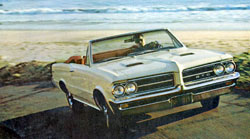1964-1973 GTO
There were other factory performance cars before the GTO, but Pontiac’s pioneering performer established the formula emulated by other manufacturers during the muscle car era. It happened in 1964 when an enterprising engineering group lead by John DeLorean shoehorned a large 389-cubic-inch engine V-8 from the full-size lineup into the intermediate Tempest body, against corporate policy. The GTO package slipped under the radar the first year as an option package, but customers took notice and bought nearly 32,500 copies of the fledgling muscle car. A year later, the GTO was a bona fide success and sales jumped to more than 75,000. Not surprisingly, that company policy against big engines in smaller cars evaporated.
 GTO models from 1964 to 1973 were based on GM’s ubiquitous A-body platform, sharing the same basic intermediate chassis, although they are divided into two generations: 1964-1967 (115-inch wheelbase) and 1968-73 (112-inch wheelbase). The first generation models are characterized by their long, low exterior styling and – apart from the 1964 model – stacked headlamps. They were also offered in coupe, hardtop and convertible body styles. GTO production reached its peak in 1966, with nearly 97,000 sold. It was also the final year for the famous Tri-Power induction system. In 1967 the GTO’s engine grew from 389 cubic inches to 400 cid.
GTO models from 1964 to 1973 were based on GM’s ubiquitous A-body platform, sharing the same basic intermediate chassis, although they are divided into two generations: 1964-1967 (115-inch wheelbase) and 1968-73 (112-inch wheelbase). The first generation models are characterized by their long, low exterior styling and – apart from the 1964 model – stacked headlamps. They were also offered in coupe, hardtop and convertible body styles. GTO production reached its peak in 1966, with nearly 97,000 sold. It was also the final year for the famous Tri-Power induction system. In 1967 the GTO’s engine grew from 389 cubic inches to 400 cid.
Here Comes the Judge
 For 1968 the A-body platform was revamped, resulting in a trimmer, more modern-looking GTO with a fastback-like profile. Along with the 3-inch-shorter wheelbase, the overall length was cut by nearly six inches and its height came down, too. There was no more coupe body, either – just hardtops and convertibles. A body-colored, urethane front bumper dubbed Endura became a signature cue of the 1968-69 models. It was designed to absorb minor parking lot mishaps.
For 1968 the A-body platform was revamped, resulting in a trimmer, more modern-looking GTO with a fastback-like profile. Along with the 3-inch-shorter wheelbase, the overall length was cut by nearly six inches and its height came down, too. There was no more coupe body, either – just hardtops and convertibles. A body-colored, urethane front bumper dubbed Endura became a signature cue of the 1968-69 models. It was designed to absorb minor parking lot mishaps.
By the time the second-generation GTO hit the street the car that started the revolution was facing stiff competition from all of Detroit’s manufacturers, especially its sister divisions within GM. The muscle car market was becoming more overt, with loud graphics and brash monikers. Pontiac’s response in 1969 was the “Judge”, an option package on the GTO that gave it bold graphics and a higher level of standard content. More than 6,800 Judges were sold that first year, including a mere 108 convertibles. Those rare ragtops remain among the most coveted muscle cars in the collector market.

End of an Era
As the muscle car era was winding down in the early 1970s, the GTO’s sales dropped precipitously. By ’73, it was no longer a separate model, but again an option package. It looked completely new and different from the 1968-72 models – along with other GM vehicles built with the more formal “Colannade” hardtop design – but rode on the same 112-inch wheelbase. Its length grew by about 5 inches and the convertible model was axed. No more Judge, either (it disappeared after 1971). The GTO returned in 1974, but on GM’s compact platform that spawned the Ventura and Chevy Nova.
With classic styling and legendary powertrains including Tri-Power and later Ram Air engines, the GTO is an American icon and a cornerstone of the collector and restoration hobby. And as one of the industry’s largest A-body restoration suppliers, Original Parts Group offers thousands of 1964-73 GTO parts and accessories, with new parts added daily. Our extensive catalog offers nearly everything from sheet metal, chrome and upholstery to engine parts and the hard-to-find details to finish a restoration with show-winning attention to detail. Our prices make that restoration more affordable, too! Shop online or order your OPG 1964-73 GTO catalog today!